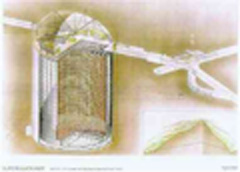 |
Neutrinos: Rocking the Model? |
 |
 |
Neutrinos are some of the most elusive fundamental particles. They are leptons with no charge and little or no mass. As a result, they interact very weakly. This means not only that neutrinos penetrate ordinary matter quite well--traveling clean through the earth, for example--but that they leave very little sign of ever having been there. However, neutrinos are detected if they pass through matter and collide with atoms and in doing so, transfer enough energy to cause detectable vibration (phonons) or Cerenkov radiation (photons). Actual neutrino detectors are highly sensitive to Cerenkov radiation and tend to be large instruments in order to maximize the probability of these rare collisions. One of the leading detectors of solar, cosmic and accelerator-generated neutrinos in the world is Super Kamiokande, located underground just outside of Kamioka, Japan. |
It has long been a staple of the Standard Model that neutrinos, like photons, have no mass. And if they have no mass, they will not spontaneously change from one type of neutrino to another. (We call such change "neutrino oscillation.") So physicists associated with Super Kamiokande set out to see if neutrinos oscillate.
Attention was placed on atmospheric neutrinos--neutrinos produced high in the atmosphere due to collisions. There are two reasons for this. First, in traveling from high in the atmosphere, neutrinos go far enough to oscillate before hitting the detector. Second, the theory behind atmospheric neutrino production is well understood and its predictions are considered valid.
In 1998, the Super Kamiokande collaboration announced the end of a 535-day run in which atmospheric neutrinos were observed and counted. They reported the number of electron neutrinos and the number of muon neutrinos detected in two energy ranges and compared the data with the expected numbers of such neutrinos produced high in the atmosphere. We reproduce that data below:
Energy Range Neutrino Type Number Detected
(Super Kamiokande data)Number Produced
(Monte Carlo data)sub-GeV range electron neutrino 1231 1049 muon neutrino 1158 1574 total 2389 2623 multi-GeV electron neutrino 290 236 muon neutrino 230 296 total 520 532 Source: Evidence for oscillation of atmospheric neutrinos, Phys Rev Lett 1998 (reproduced on Website http://www.ps.uci.edu/~superk/ )
Analysis:
- What are the proportions of electron and muon neutrinos produced in the upper atmosphere (Monte Carlo data)?
- What are the proportions of electron and muon neutrinos detected under the ground (Super Kamiokande data)?
- Do the proportions change? Why would they?
- Does this data indicate neutrino oscillations occurred? How?
- How might your conclusion above be disputed?
- What further tests can be done to confirm or deny neutrino oscillations?
- What does this say about the Standard Model?
To analyze neutrino oscillations further, go to the article "Neutrinos Have Mass"
by John G. Learned in the Winter 1999 issue of the SLAC publication
Beamline